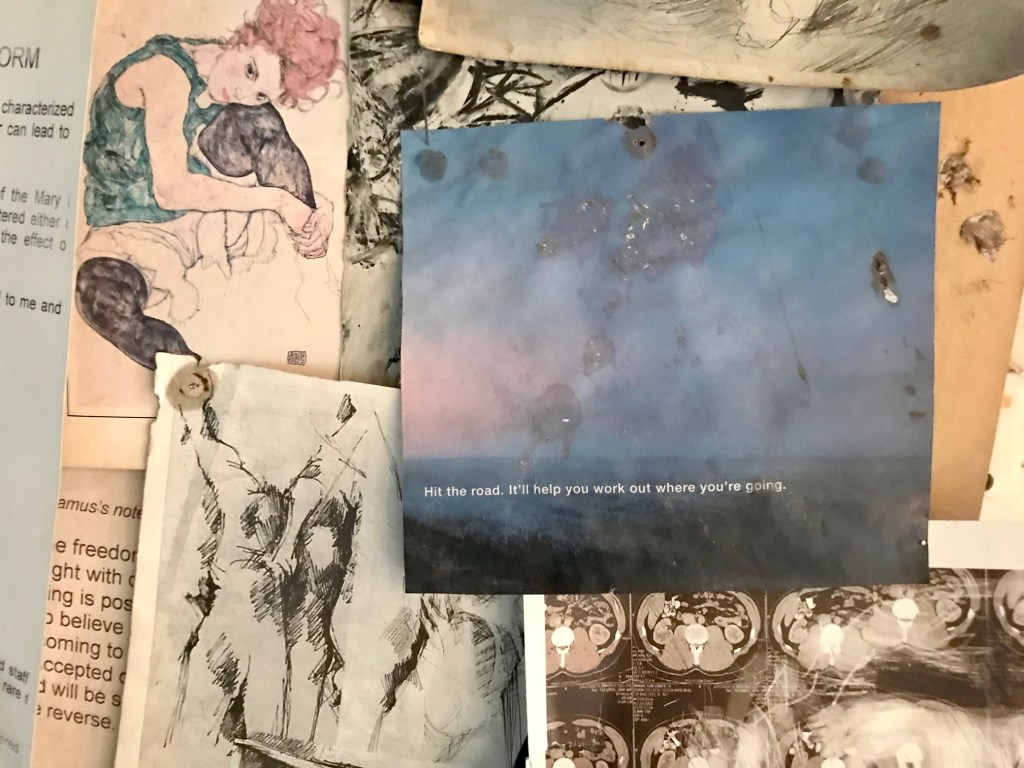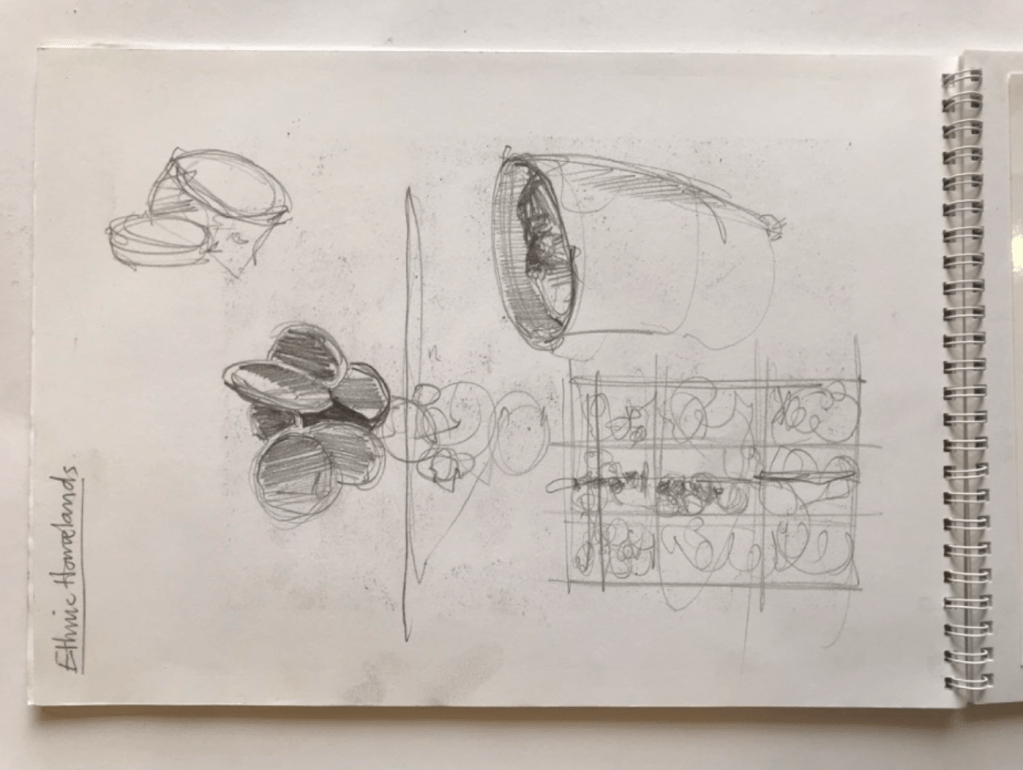
Hit the road. It’ll help you work out where you’re going
Nike Advertisement
I begun thinking about boundaries with regard to our national perimeter as I wrote of in previous posts (Outlines and Outlines One and Two). As I thought about this framework, it seemed to fall into three conceptual sections, the last of which was the present condition of the nation state which I touched on previously, and within which most of my work will emerge. It relates to my own conditions and my present, and is the position where my voice is most authentic. Like any area of inquiry, as you look, it just seems to get bigger and bigger and trying to find a point of focus becomes harder the more you look at it and think about it.
I needed to find a means of accessing the concepts, a starting point somehow, a window or opening. Art making is different to speaking and writing, I think. There is less definition, thoughts and ideas hang onto the work, or can be attached to the work, or can be interpreted from the work but the work itself is less explicit, perhaps closer to poetry and certain forms of than to writing.
I began thinking about the work in relation to the initial drawing of the boundaries, proceeding from the partitioning of Southern Africa at the Berlin conference of 1893/94, and the Royal Charter of 1889. I wanted to incorporate some of the materials I had used up till now – it has never worked for me to make radical changes in direction in terms of media, a gradual and organic transition has always been the way I have worked. But I did want to be able to introduce new ideas and materials and was open to any ideas.
The entry point into the Matabele territory at the Shashe river by the BSAC, and the establishment of Fort Tuli and the Tuli Circle provided the starting point for both the aesthetic qualities and the specific materials employed. Tuli circle is significant for two reasons; firstly, it is the point at which the pioneer column entered what is now known as Zimbabwe as they crossed the Shashe river. Secondly, as the name implies, there is a mathematically drawn semi-circle, which departs from the borderline running down the thalweg of the Shashe river, and follows an arc at a 10 mile radius from Fort Tuli, the site of the original pioneer camp. The circle demarcated an area defined in agreement between the pioneers and the local inhabitants, within which the cattle belonging to the local inhabitants would not be allowed to enter. The reason for being to protect the oxen of the column from the rinderpest disease that was inflicting the cattle and prevalent throughout southern Africa at this time. As the border became formalised, the circle became incorporated into the national boundary.
The second section has its roots in the 1964 conference of the AOU in Cairo. At this meeting, the declaration that the borders of African States on the day of their independence constituted a “tangible reality”, the participants pledged that they would respect the borders uti possedetis juris1 as determined in the declaration (UNGA 1964: 172). The acceptance of these borders may be read not as an acceptance of this aspect of colonial legacy, but as an acknowledgement of an irreversible reconfiguration of the nature of the respective territories.
As I began to think about work relating to the above, I began to see how these two concepts might give rise to the materials I might use, and underpin ideas of form and structure. Ideas about making lines, division, violence and imposing structures on top of structures. Ideas of incongruence and immutability, of structures and boundaries. As I did so, different materials and different forms begun to emerge. The circle motif derived from Tuli was a starting point, but more importantly, the idea of cattle horns emerged as visual metaphors, or carriers of meaning within the work.
I keep the advert for Nike above stuck up in my studio, and it’s a phrase I often repeat it to my pupils. Art making is a creative process, and one more inclined toward discovery, rather than merely making solutions or representations of ideas – I am reminded of the wonderful quote of William Kentridge, “in the process of making, meaning will emerge”. Early works are in progress, whilst ideas pile up as some sort of backlog in my head – most of those are discarded along the way, but others emerge as I continue to figure out where I’m going.
Greg Shaw,
Harare, 26 April 2021
Notes
- uti possidetis juris (UPJ) is a principle of customary international law that serves to preserve the boundaries of colonies emerging as States. Originally applied to establish the boundaries of decolonized territories in Latin America, UPJ has become a rule of wider application, notably in Africa. The policy behind the principle has been explained by the International Court of Justice in the Frontier Dispute (Burkina Faso/Mali) Case:
“[UPJ is a] general principle, which is logically connected with the phenomenon of the obtaining of independence, wherever it occurs. It’s obvious purpose is to prevent the independence and stability of new States being endangered by fratricidal struggles provoked by the challenging of frontiers following the withdrawal of the administering power…Its purpose, at the time of the achievement of independence by the former Spanish colonies of America, was to scotch any designs which non-American colonizing powers might have on regions which had been assigned by the former metropolitan State to one division or another, but which were still uninhabited or unexplored.” (Cornell Law School [O], Legal Information Institute. “Uti Possidetis juris”. Available at: https://www.law.cornell.edu/wex/uti_possidetis_juris). - United Nations General Assembly, 1964. Resolutions Adopted by the First Ordinary Session of the Assembly of Heads of State and Government held in Cairo, UAR from 17 20 21 July 1964.













Thank you for the insights Greg- I need that artistic inspiration, that impetus right now and you have just given it to me . …the wonderful quote of William Kentridge, “in the process of making, meaning will emerge” resonates deeply -my interest in cattle , boundaries and fences dates from my translocation to the Save Vslley Conservancy and my journeys through gonarezhou- people translocations, cattle and wildlife conflicts –
One of my blogs – #cattle #boundaries #oriple #wildlife https://wineandwilddogs.art/2021/04/20/living-with-cattle-and-wildlife-ecological-dancing/
Thanks Lin – like any subject, as you begin to think about it, it just gets bigger and bigger. The Kentridge quote is one of my mainstays!